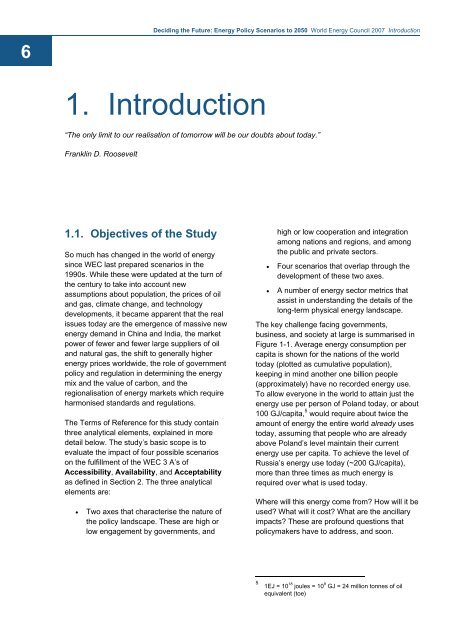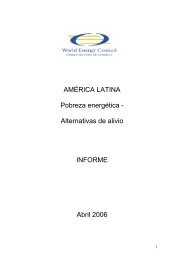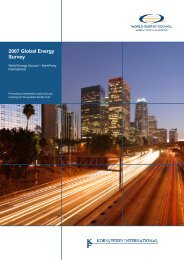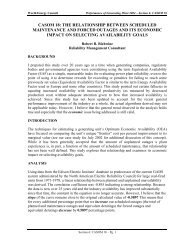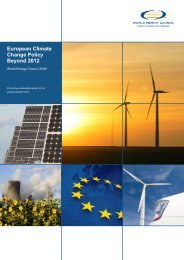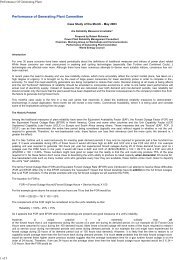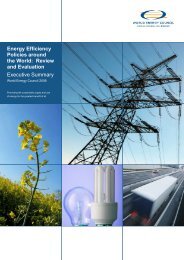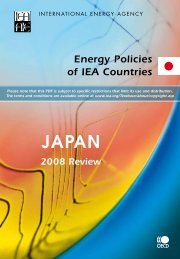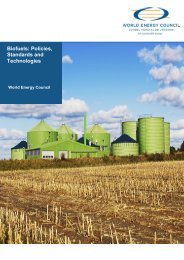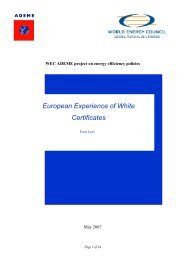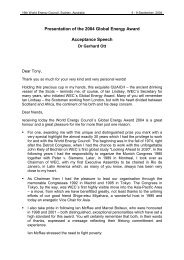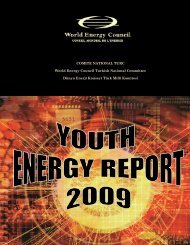Deciding the Future: Energy Policy Scenarios to 2050
Deciding the Future: Energy Policy Scenarios to 2050
Deciding the Future: Energy Policy Scenarios to 2050
Create successful ePaper yourself
Turn your PDF publications into a flip-book with our unique Google optimized e-Paper software.
6<br />
<strong>Deciding</strong> <strong>the</strong> <strong>Future</strong>: <strong>Energy</strong> <strong>Policy</strong> <strong>Scenarios</strong> <strong>to</strong> <strong>2050</strong> World <strong>Energy</strong> Council 2007 Introduction<br />
1. Introduction<br />
“The only limit <strong>to</strong> our realisation of <strong>to</strong>morrow will be our doubts about <strong>to</strong>day.”<br />
Franklin D. Roosevelt<br />
1.1. Objectives of <strong>the</strong> Study<br />
So much has changed in <strong>the</strong> world of energy<br />
since WEC last prepared scenarios in <strong>the</strong><br />
1990s. While <strong>the</strong>se were updated at <strong>the</strong> turn of<br />
<strong>the</strong> century <strong>to</strong> take in<strong>to</strong> account new<br />
assumptions about population, <strong>the</strong> prices of oil<br />
and gas, climate change, and technology<br />
developments, it became apparent that <strong>the</strong> real<br />
issues <strong>to</strong>day are <strong>the</strong> emergence of massive new<br />
energy demand in China and India, <strong>the</strong> market<br />
power of fewer and fewer large suppliers of oil<br />
and natural gas, <strong>the</strong> shift <strong>to</strong> generally higher<br />
energy prices worldwide, <strong>the</strong> role of government<br />
policy and regulation in determining <strong>the</strong> energy<br />
mix and <strong>the</strong> value of carbon, and <strong>the</strong><br />
regionalisation of energy markets which require<br />
harmonised standards and regulations.<br />
The Terms of Reference for this study contain<br />
three analytical elements, explained in more<br />
detail below. The study’s basic scope is <strong>to</strong><br />
evaluate <strong>the</strong> impact of four possible scenarios<br />
on <strong>the</strong> fulfillment of <strong>the</strong> WEC 3 A’s of<br />
Accessibility, Availability, and Acceptability<br />
as defined in Section 2. The three analytical<br />
elements are:<br />
• Two axes that characterise <strong>the</strong> nature of<br />
<strong>the</strong> policy landscape. These are high or<br />
low engagement by governments, and<br />
high or low cooperation and integration<br />
among nations and regions, and among<br />
<strong>the</strong> public and private sec<strong>to</strong>rs.<br />
• Four scenarios that overlap through <strong>the</strong><br />
development of <strong>the</strong>se two axes.<br />
• A number of energy sec<strong>to</strong>r metrics that<br />
assist in understanding <strong>the</strong> details of <strong>the</strong><br />
long-term physical energy landscape.<br />
The key challenge facing governments,<br />
business, and society at large is summarised in<br />
Figure 1-1. Average energy consumption per<br />
capita is shown for <strong>the</strong> nations of <strong>the</strong> world<br />
<strong>to</strong>day (plotted as cumulative population),<br />
keeping in mind ano<strong>the</strong>r one billion people<br />
(approximately) have no recorded energy use.<br />
To allow everyone in <strong>the</strong> world <strong>to</strong> attain just <strong>the</strong><br />
energy use per person of Poland <strong>to</strong>day, or about<br />
100 GJ/capita, 5 would require about twice <strong>the</strong><br />
amount of energy <strong>the</strong> entire world already uses<br />
<strong>to</strong>day, assuming that people who are already<br />
above Poland’s level maintain <strong>the</strong>ir current<br />
energy use per capita. To achieve <strong>the</strong> level of<br />
Russia’s energy use <strong>to</strong>day (~200 GJ/capita),<br />
more than three times as much energy is<br />
required over what is used <strong>to</strong>day.<br />
Where will this energy come from? How will it be<br />
used? What will it cost? What are <strong>the</strong> ancillary<br />
impacts? These are profound questions that<br />
policymakers have <strong>to</strong> address, and soon.<br />
5<br />
1EJ = 10 18 joules = 10 9 GJ = 24 million <strong>to</strong>nnes of oil<br />
equivalent (<strong>to</strong>e)


